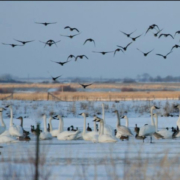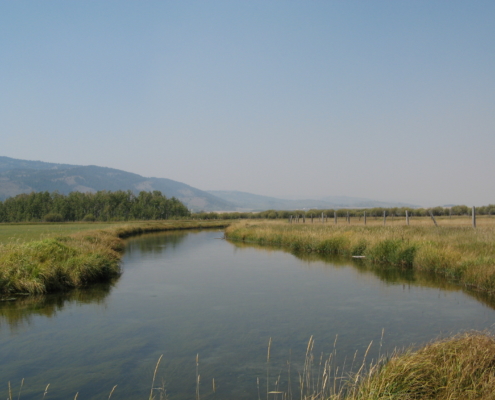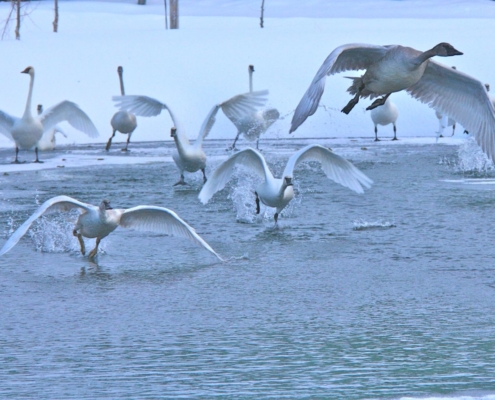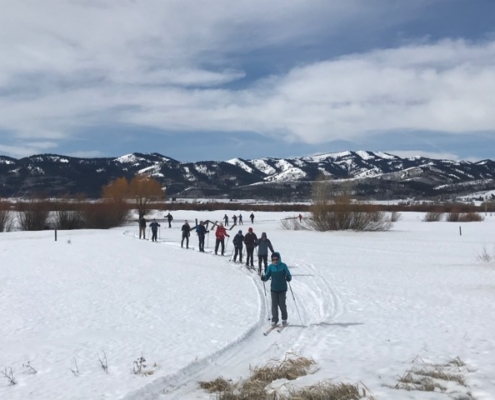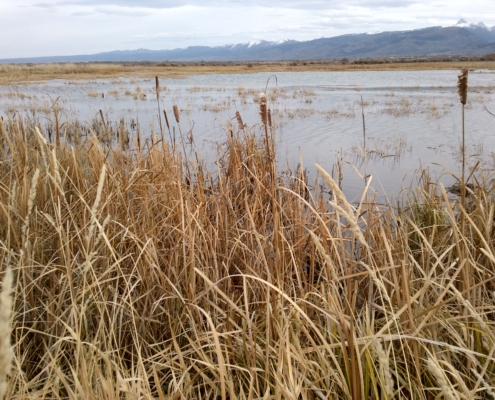A Family’s Conservation Legacy on Fox Creek
by Nancy Huntsman
My late husband, Blaine, was an Idaho boy. He and his brother grew up in and around Pocatello in the 1940s and 50s where their father was a school teacher. As boys, they fished any creek they could reach by bicycle. Though the family later moved away, Blaine always looked for reasons to return to his favorite landscape. Later in life, he started traveling to Teton Valley for fishing trips with the Teton Valley Lodge. Once he was able, he bought a small cabin next to the Lodge. That became our family retreat for a good many happy years. Along the way, a friend and fishing guide introduced him to Fox Creek Ranch, and that is when our adventure began.
Fox Creek was a working ranch with summer pasture, a hay crop, and a spring creek flowing through the middle before joining the Teton River. I hadn’t even seen the property when Blaine announced to me that we were buying it. I was startled, of course, but his excitement at the prospect of ready access to the creek overshadowed my concerns, at least until my first visit. It was hard to see the place the way he did. Yes, it had a certain charm and pastoral quality. There were cows and lovely, undulating lines of fresh-cut hay. There were beautiful views of the Tetons, but the spring creek looked like it was in rough shape. Still, it would be a refuge for our family, a place we could fish with our kids, where they could discover nesting birds hidden among the grasses, and experience the majesty of stars on a clear night.
That summer, we came to understand that our little spring creek had a heap of problems. It was badly silted up, with steep collapsing banks and almost no cover. Where had all the willows gone? About the same time, we began to hear concerns from our fishing friends about the Teton River– fishermen were still catching the big fish that have made the Teton famous, but the smaller fish had gone missing. (Later studies showed a 95% decline in the endemic Yellowstone cutthroat trout.) Their absence pointed straight back to the Teton’s spawning tributaries, one of was which Fox Creek.
In no time at all what began as a romantic notion of a pretty ranch graced with a spring creek, became a major restoration project. It was an odyssey that along the way, transformed our family and our relationship to the land.
When we began, we really had no idea of the scope of the undertaking, the underlying science, or the regulatory world. Let’s just say, we learned a thing or two. We began as earnest landowners, and by the time we finished – thirteen years later– we had made new friends, broadened our vocabulary, and gained a deep understanding of the interconnectedness of water, land, and wildlife.
Those new friends included the Friends of the Teton River and the very capable people at the Teton Regional Land Trust and Ducks Unlimited. They put us in touch with scientists, stream specialists, and plant and fishery biologists. Foremost among them was Scott Gillilan (Gillilan Assoc), a biologist and hydrologist, whose pioneering restoration methods made all the difference. Scott and the Land Trust guided us through an alphabet soup of regulatory agencies: Idaho Fish and Wildlife Foundation, Idaho Department of Water Resources, Idaho Department of Environmental Quality, and The Army Corps of Engineers, to name just a few. We worked with different contractors, but happily settled on Arlin Grimes (Aqua Terra Restoration) here in Driggs–because he not only understood the vision, but he had an almost intuitive understanding of stream hydrology.
Through our many, many, many meetings with these agencies and their hard-working professional staff, we learned about stream form and speed-of-flow, and pool-riffle-run bedform geometry. The Land Trust staff helped us to understand the broader concept of riparian corridors. The fisheries biologists educated us about the Yellowstone cutthroat trout, its habitat, the need to restore spawning gravels, and concerns with competing species.
From Ducks Unlimited, we learned about the importance of migratory birds, native wetland grasses, and the threat of invasive plant species. A wetland plant materials specialist from Aberdeen, Idaho, taught us about willow varieties, explaining their propagation, and value for bank stabilization. Along the way, Blaine’s son, Beach, who had been all across the world as a river guide, came home to join us. He became a willow expert in his own right as he guided teams of hardy volunteers from the Land Trust, Grand Targhee, and around the valley to harvest and transplant over 20,000 native willow cuttings and almost 1,000 trees and shrubs.
We began to observe and identify the many bird species around us. Alongside the pros, we measured sediment, and turbidity, and gravel matrices. We helped with fish counts and redd counts. And while doing all of that, we spent 3 years arguing with regulators to grant us permits for a kind of in-stream excavation that had never before been allowed in the Henry’s Fork Watershed.
Finally, with the help of an abundantly talented team of committed people, we succeeded. We worked for thirteen years through four phases of permitting to restore more than two miles of Fox Creek and a half-mile of Little Fox Creek. We planted thousands of willows and other native vegetation. We excavated a series of three large wetland ponds, creating more than 30 acres of open water and marsh. All of this worked to the benefit of aquatic, riparian, wetland, and upland habitats.
How do we know what the hard work accomplished? In June 2019, Friends of the Teton River issued a report summarizing Teton River trout densities between 2003-2017. By their counts, Yellowstone cutthroat trout numbers went from 14 per mile to 936. All trout species went from 420 per mile to 3,867. We have seen otter and mink return to the creek. Increasing numbers and varieties of birds are nesting, foraging, and staging throughout the year.
We set out to transform a creek and along the way we transformed our family as well. Beach stayed on to manage the ranch and make his home in the valley. As we came to understand the roles of water, land, and wildlife, we modified our ranch practices to safeguard the land and water. Wildlife, especially fish and birds, responded. Because of our work together throughout the project, we turned to the Teton Regional Land Trust, and with them worked out our first conservation easement in 2007.
Part of Blaine’s legacy to his family was to instill in us a love for this land and a commitment to take care of it. We have been stewards of Fox Creek Ranch for 23 years. Last year our family put an additional 100 acres under easement to further protect this thriving riparian landscape. We are grateful to the Land Trust for working with us over the years, to help guide our restoration projects, and to help us preserve our land while maintaining it as a productive ranch. It has been an amazing adventure!
